Spanish Fork Wellbeing Survey Findings
May 2021

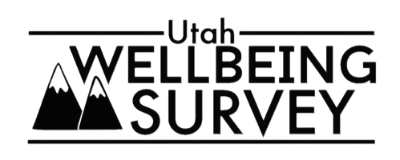
Summary
Spanish Fork City is one of 30 cities currently participating in the Utah Wellbeing Survey Project in 2021. This project is designed to assess the wellbeing and local perspectives of city residents and to provide information to city leaders to inform their general planning process. It is important to note that the 2021 survey was conducted during the COVID-19 pandemic. This was intentional as the last round of wellbeing surveys were conducted in 2020 prior to the pandemic. This allows us to assess changes at this unique period of time. Future surveys are anticipated to gauge recovery.
What is in this report?
This report describes findings from the 2021 Spanish Fork survey as well as some comparative information with other project cities. Feedback from city leaders and planners is welcome. We will continue with analysis and reporting.
How was the survey conducted?
In January and February 2021, Spanish Fork City advertised the survey via monthly newsletter to all households, social media, survey panel, and city website. All city residents age 18+ were encouraged to take the online Qualtrics survey.
How many people responded?
- 770 viable surveys were recorded in this 2021 effort with 83% complete responses.
- The adult population of Spanish Fork was estimated at 24,234 based on the 2015-2019 American Community Survey. The survey responses represent 3.2% of the adult population and have a conservative margin of error of 3.48%.
Key Findings in Spanish Fork
Overall Personal Wellbeing and Community Wellbeing in Spanish Fork were above average among 29 study cities. Age, gender, and religion were influential factors related to wellbeing.
Highest Rated Wellbeing Domains:
- Living Standards
- Safety and Security
Most Important Wellbeing Domains:
- Safety and Security
- Mental Health
- Physical Health
- Living Standards
Red Zone Domain: (High Importance, Low Rating)
- Physical Health
- (Mental Health approaches this zone)
COVID-19 had greatest impact on Social Connections, Cultural Opportunities, and Mental Health. Overall personal wellbeing declined in last year for 41% of respondents. Community wellbeing was more likely to decline for those living in Spanish Fork longer than 5 years. Living standards and mental health were more likely to decline for those without a college degree.
The majority of respondents felt Population Growth was too fast, but attitudes were more divided about the Pace of Economic Development.
Top concerns for the future of Spanish Fork were:
- Roads and Transportation (69% Moderate or Major Concern)
- Affordable Housing (69% Moderate or Major Concern)
- Air Quality (69% Moderate or Major Concern)
What do people value most about Spanish Fork?
Small town feel, good amenities, abundant recreation, well-run government, and access to nature.
Survey Respondent Characteristics
| Full Time Residents of Spanish Fork | 98.3% | Map Area 1 | 1.5% |
| Part Time Residents of Spanish Fork | 1.7% | Map Area 2 | 4.5% |
| Length of Residency - Range | 0-78 years | Map Area 3 | 18.2% |
| Length of Residency - Average | 18 years | Map Area 4 | 18.1% |
| Length of Residency - Median | 12 years | Map Area 5 | 12.5% |
| Length of Residence 5 Years or Less | 31.2% | Map Area 6 | 41.2% |
| Map Area 7 | 4.1% |
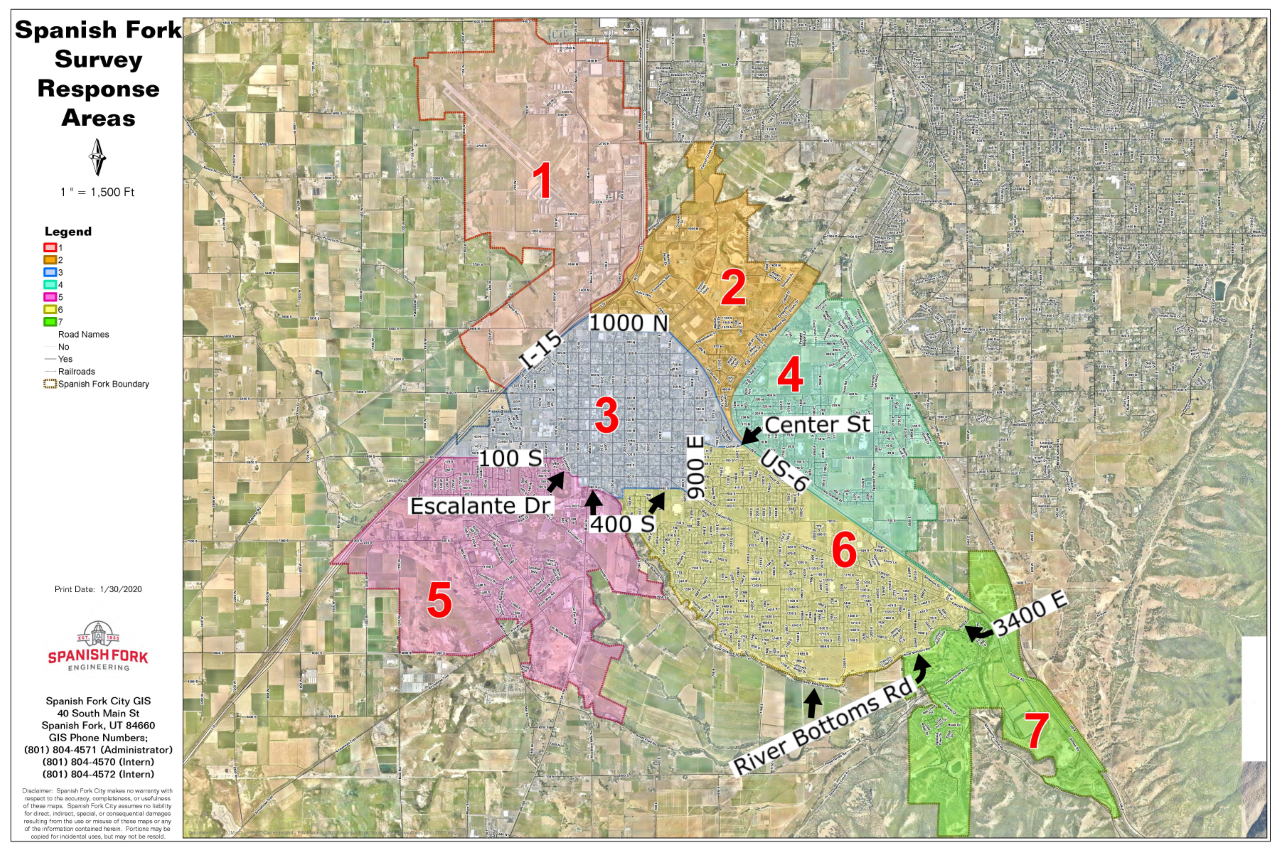
Demographic characteristics of the survey respondents are compared below with U.S. Census information from the 2015-2019 American Community Survey. As the table shows, survey respondents were not fully representative of Spanish Fork. People who are female, have at least a 4-year college degree, are married, have children in household, and own their home were particularly overrepresented. People age 18-29 are particularly underrepresented. Not all respondents provided demographic information. Weighting was not used in any of the analysis for the findings presented below. Updates will be provided later in 2021 to account for weighting by demographic characteristics.
Table 1
Demographic Characteristics of Survey Respondents and U.S. Census Data for Spanish Fork
| Demographic Characteristics | Spanish Fork Online Wellbeing Survey 2021 (N=770) |
American Community Survey 2016-2020 Estimates |
|---|---|---|
| Age 18-29 | 6.7% | 28.2% |
| Age 30-39 | 25.1% | 24.1% |
| Age 40-49 | 31.3% | 17.8% |
| Age 50-59 | 17.3% | 13.0% |
| Age 60-69 | 13.7% | 8.3% |
| Age 70 or over | 5.8% | 8.6% |
| Adult female | 68.6% | 49.7% |
| Adult male | 31.4% | 50.3% |
| No college degree | 44.9% | 65.2% |
| College degree (4-year) | 55.1% | 34.8% |
| Median household income | NA | $79,846 |
| Income under $25,000 | 2.7% | 7.5% |
| Income $25,000-$49,999 | 11.8% | 16.8% |
| Income $50,000 to $74,999 | 18.3% | 21.3% |
| Income $75,000 to $99,999 | 20.7% | 16.8% |
| Income $100,000 to $149,999 | 31.0% | 26.6% |
| Income $150,000 or over | 4.3% | 10.9% |
| Latter-day Saint | 61.6% | NA |
| Other religion | 19.8% | NA |
| No religious preference | 18.6% | NA |
| Hispanic/Latino | 4.8% | 11.5% |
| White | 94.6% | 84.0% |
| Nonwhite | 5.4% | 16.0% |
| Married | 84.8% | 63.5% |
| Children under 18 in household | 59.5% | 55.3% |
| Employed (combined) | 63.7% | 67.7% |
| Out of work and looking for work | 1.5% | 1.3% |
| Other | 34.8% | 30.6% |
| Own home/owner occupied | 90.0% | 75.3% |
| Rent home/renter occupied/other | 10.0% | 24.7% |
Overall Personal Wellbeing and Overall Wellbeing in Spanish Fork
Survey participants were asked about their overall personal wellbeing and overall community wellbeing in Spanish Fork. These wellbeing indicators both measured on a 5-point scale from very poor (1) to excellent (5). The average personal wellbeing score in Spanish Fork was 4.06, with 81% of respondents indicating their wellbeing at a 4 or 5 on the 5-point scale. The average score for community wellbeing in Spanish Fork was 3.87 with 70% of respondents indicating city wellbeing at a 4 or 5 on the 5-point scale.
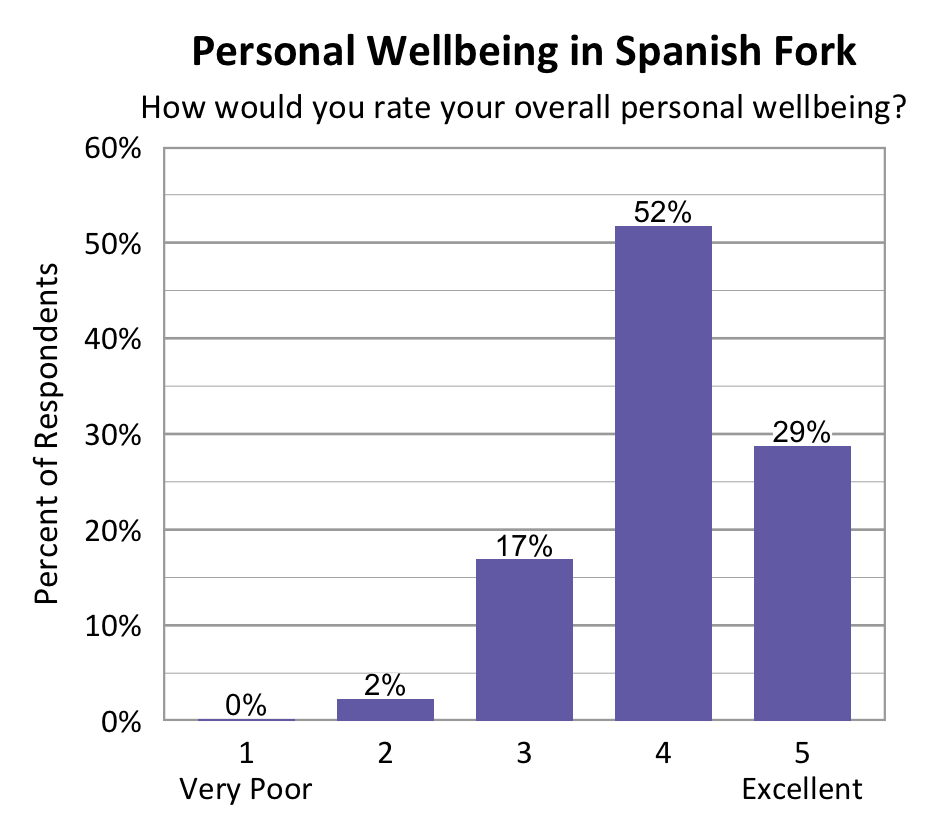
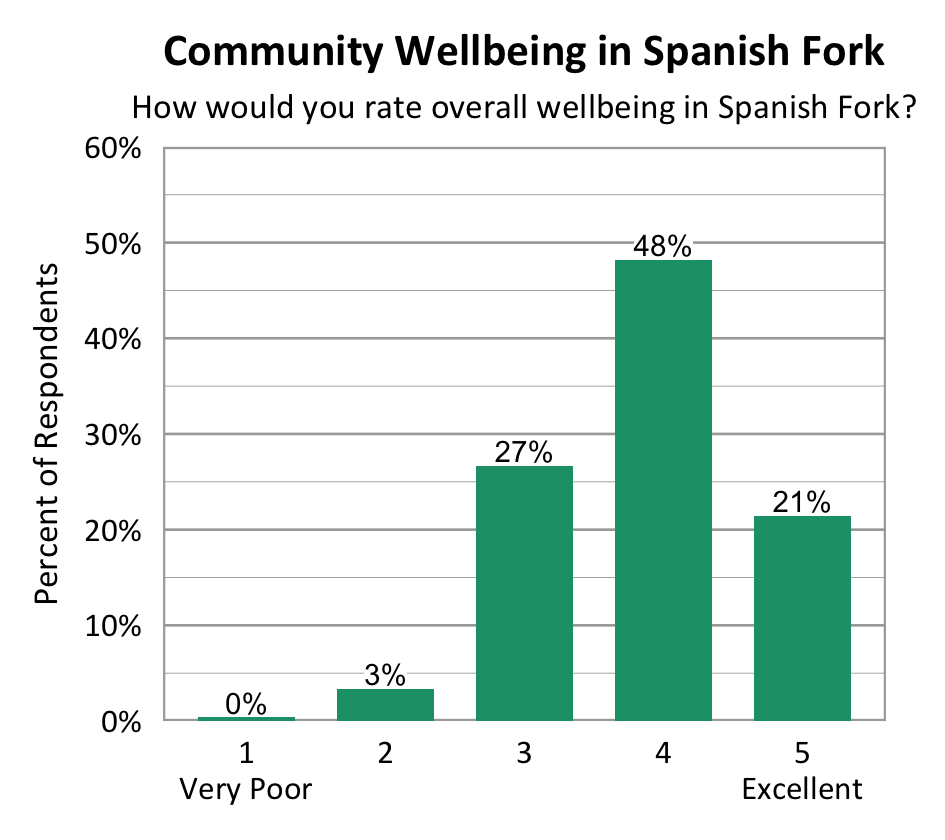
The COVID-19 pandemic dominated much of 2020. Survey respondents were asked if their overall personal wellbeing or wellbeing had changed in the last year. Survey findings show that 41% of respondents indicated that their personal wellbeing declined in that time and 36% of respondents indicated that wellbeing in Spanish Fork declined as well.
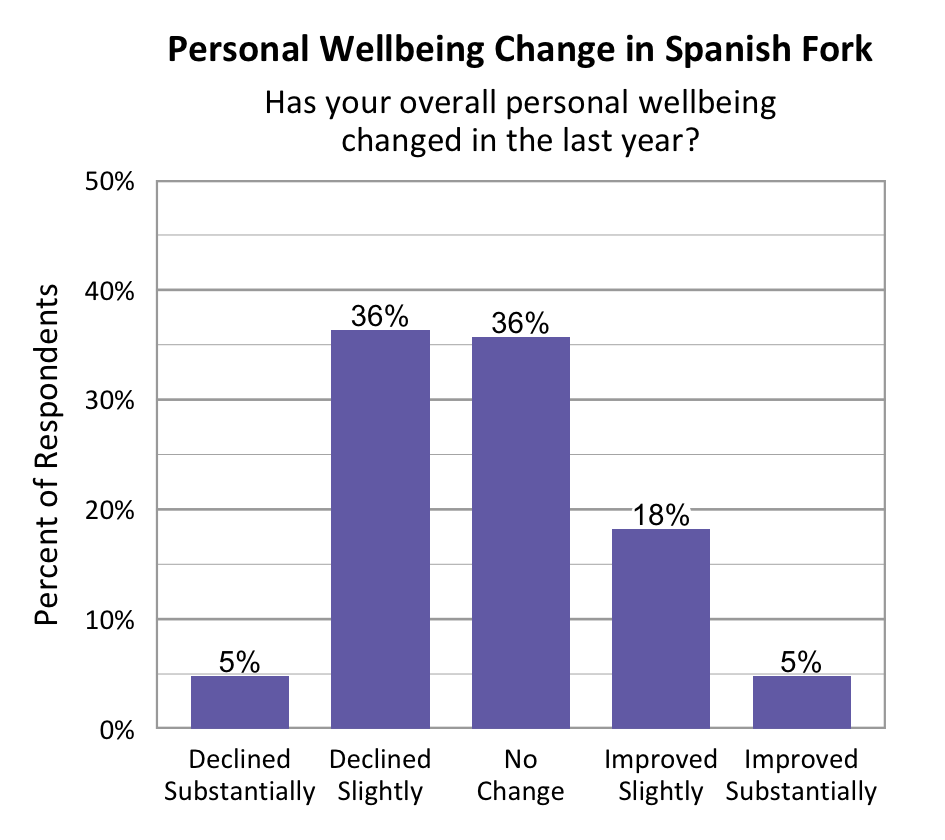
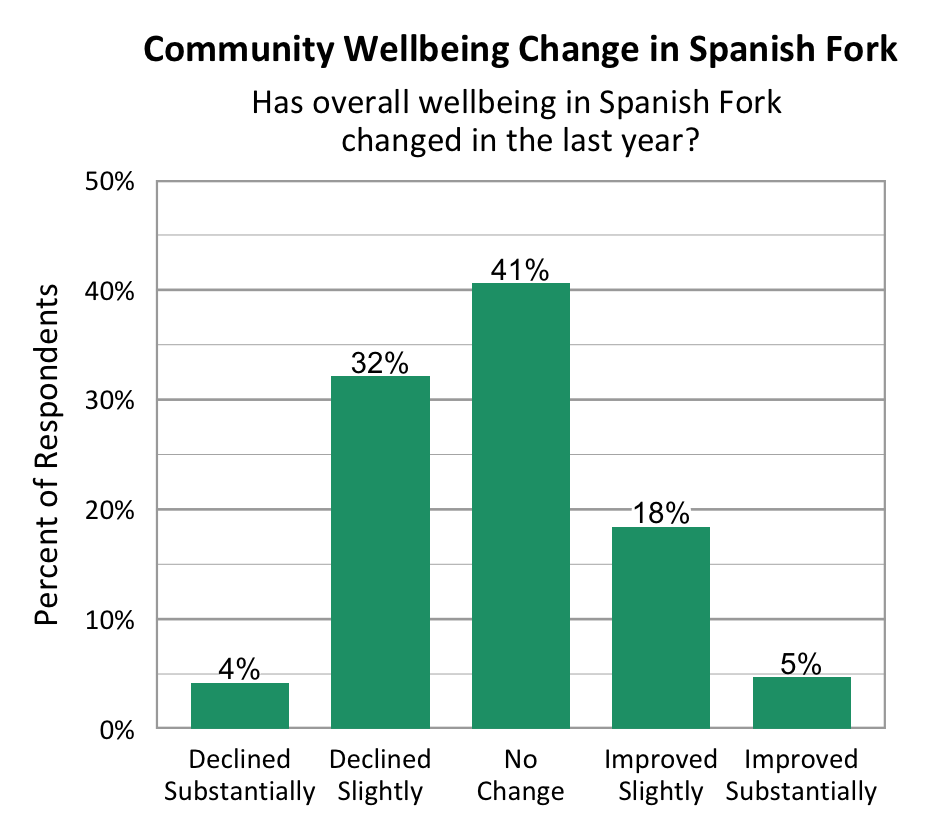
Comparing Wellbeing Across Utah Cities
The Utah League of Cities and Towns classifies Spanish Fork as a Rapid Growth City. Within this cluster of cities, Spanish Fork falls above average in terms of the average overall personal wellbeing score and average community wellbeing score. Spanish Fork is not statistically significantly different from the other cities in this cluster in terms of overall personal wellbeing, but it is significantly higher than Lehi, Santaquin, Nephi, Ephraim, and Herriman on overall community wellbeing.
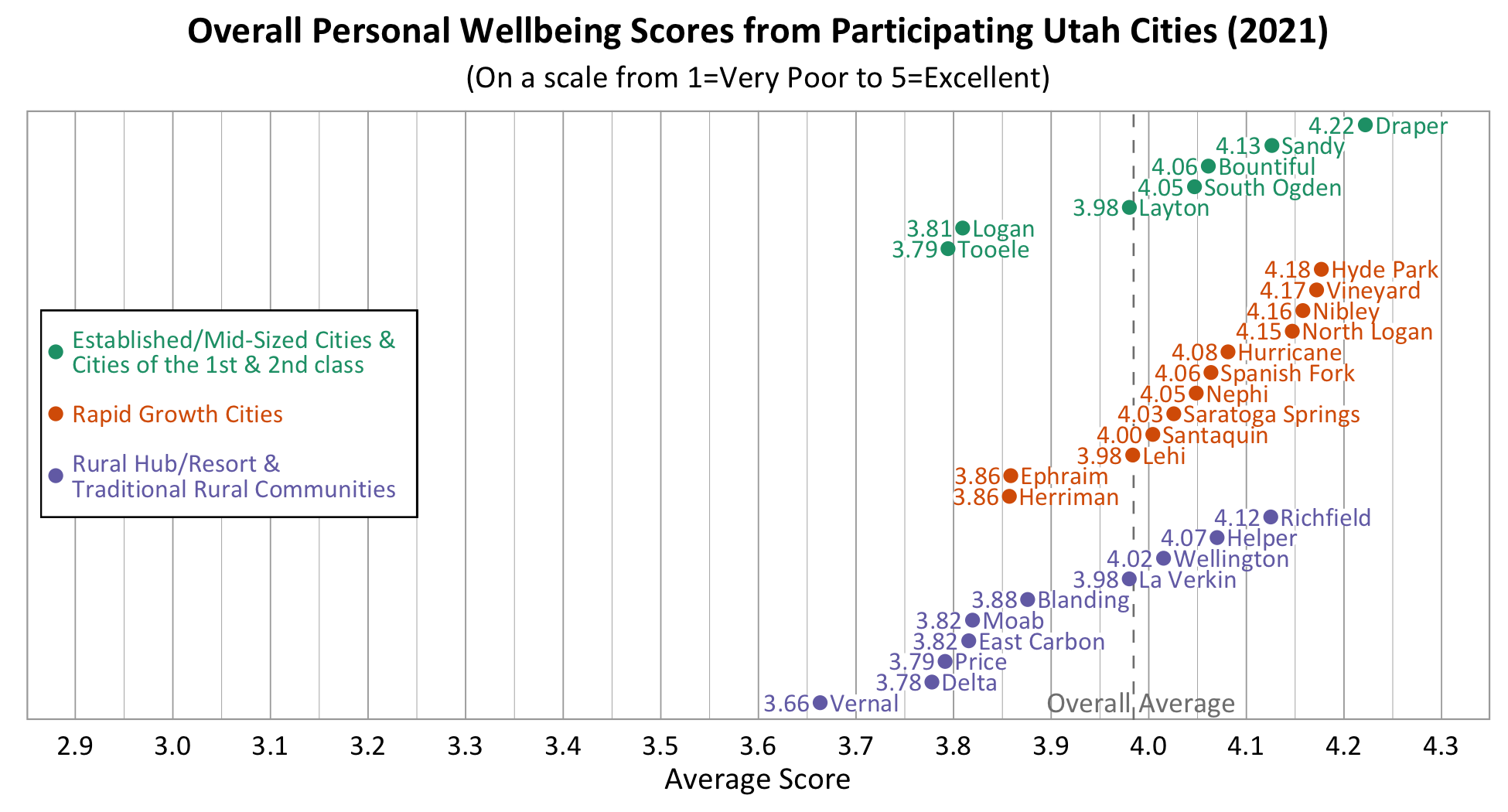
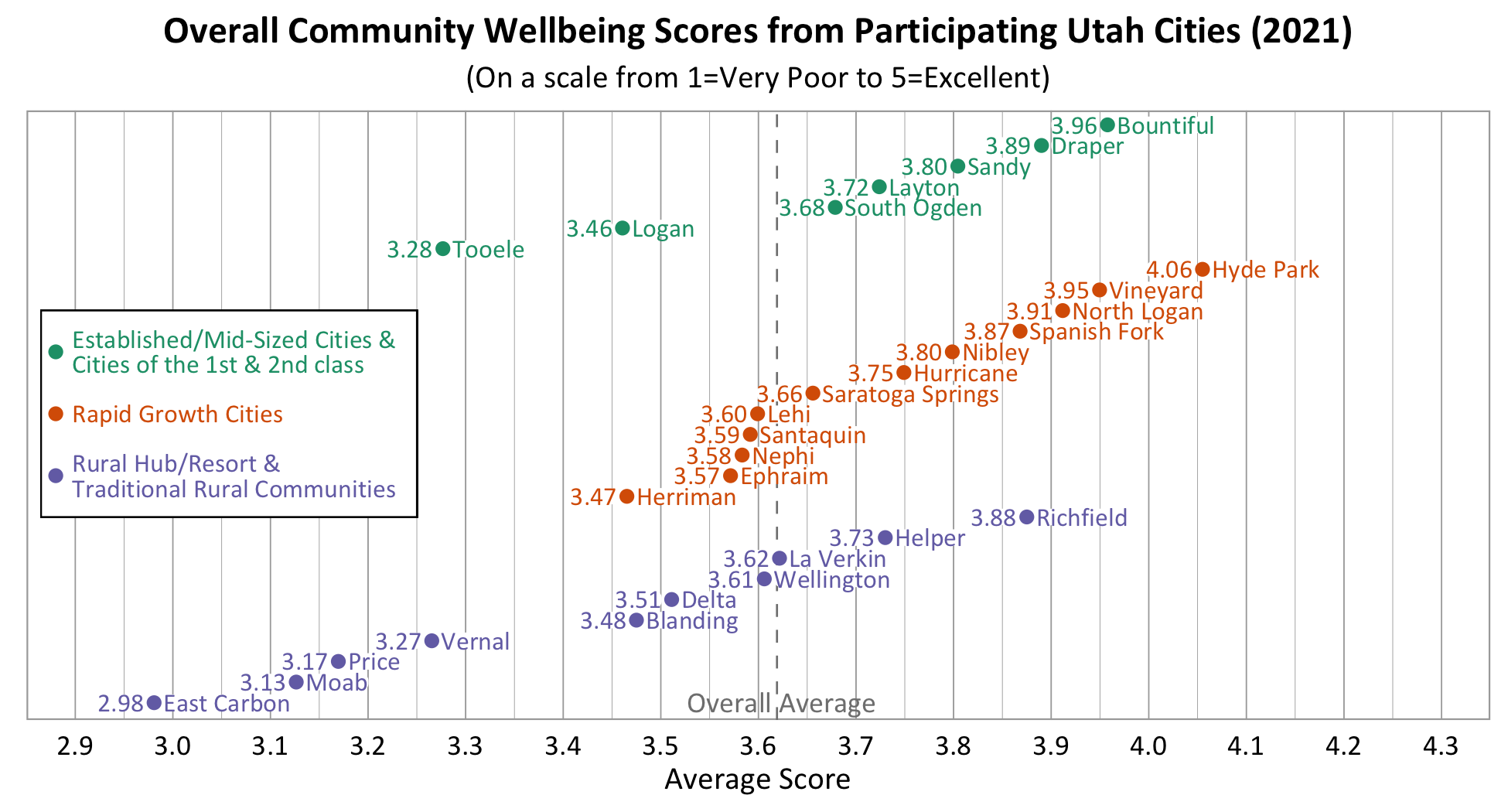
Wellbeing Domains in Spanish Fork
According to national and international entities that track wellbeing, there are a number of common dimensions or domains of wellbeing. In this survey, respondents rated ten domains on a 5-point scale from poor to excellent, suggesting how their wellbeing was doing well in each area. They were also asked to indicate the importance of each domain to their overall personal wellbeing on a 5-point scale from not at all important to very important. The top two highest rated wellbeing domains for respondents in Spanish Fork were Living Standards and Safety and Security. The two most important wellbeing domains were Safety and Security and Mental Health.

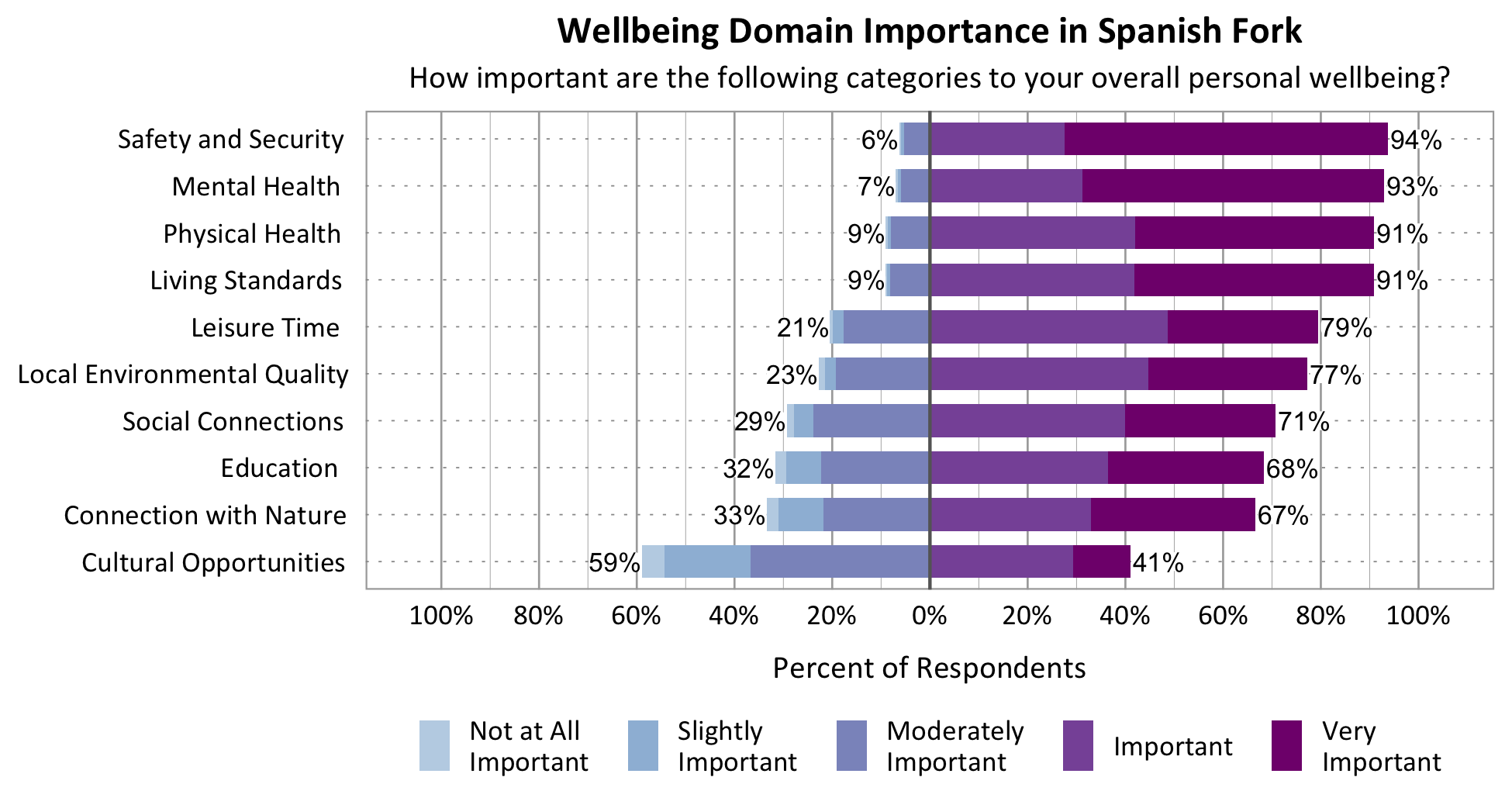
Wellbeing Matrix for Spanish Fork
The graph below illustrates the relationship between the average rating and the average importance of wellbeing domains for survey respondents from Spanish Fork. Living Standards and Safety and Security were highly important and highly rated. Physical Health falls into the red quadrant or “Red Zone”, indicating that it was of higher-than-average importance, but rated lower than average. Mental Health approaches this quadrant as its importance was close to the overall average domain importance, but rating fell below the overall average rating. Please note that all domains except for cultural opportunities had an average rating above 3.0 (moderate) and the importance score for all domains was higher than 3.0 (moderately important).
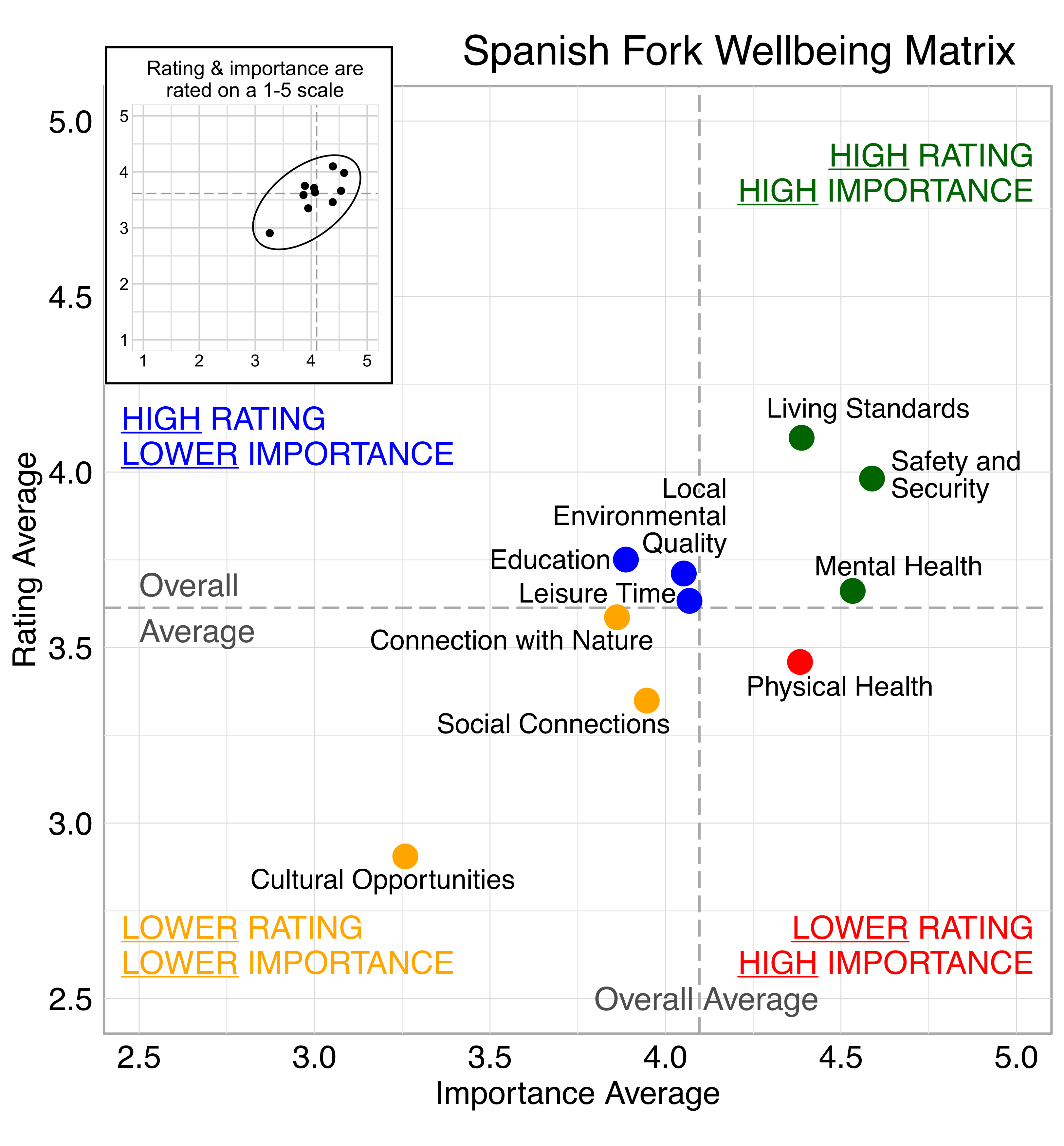
Does wellbeing vary across neighborhood areas in Spanish Fork?
Overall personal wellbeing and city wellbeing varied by respondent’s self-identified area of residence, but these differences were not statistically significant.
- Map Area 1 (n=11) Overall Wellbeing Average 4.45 City Wellbeing Average 3.91
- Map Area 2 (n=34) Overall Wellbeing Average 4.24 City Wellbeing Average 3.94
- Map Area 3 (n=138) Overall Wellbeing Average 3.98 City Wellbeing Average 3.78
- Map Area 4 (n=137) Overall Wellbeing Average 4.00 City Wellbeing Average 3.90
- Map Area 5 (n=95) Overall Wellbeing Average 4.06 City Wellbeing Average 3.87
- Map Area 6 (n=312) Overall Wellbeing Average 4.10 City Wellbeing Average 3.88
- Map Area 7 (n=31) Overall Wellbeing Average 4.13 City Wellbeing Average 3.97

How did the COVID-19 Pandemic Impact Wellbeing Domains?
The COVID-19 pandemic’s impact was most strongly felt regarding Social Connections, Cultural Opportunities, and Mental Health as shown in the graph below. No change was reported by most Spanish Fork respondents for the areas of Safety and Security, Local Environmental Quality, and Living Standards. Improvements were reported by 18% of respondents for Leisure Time and Connection to Nature.
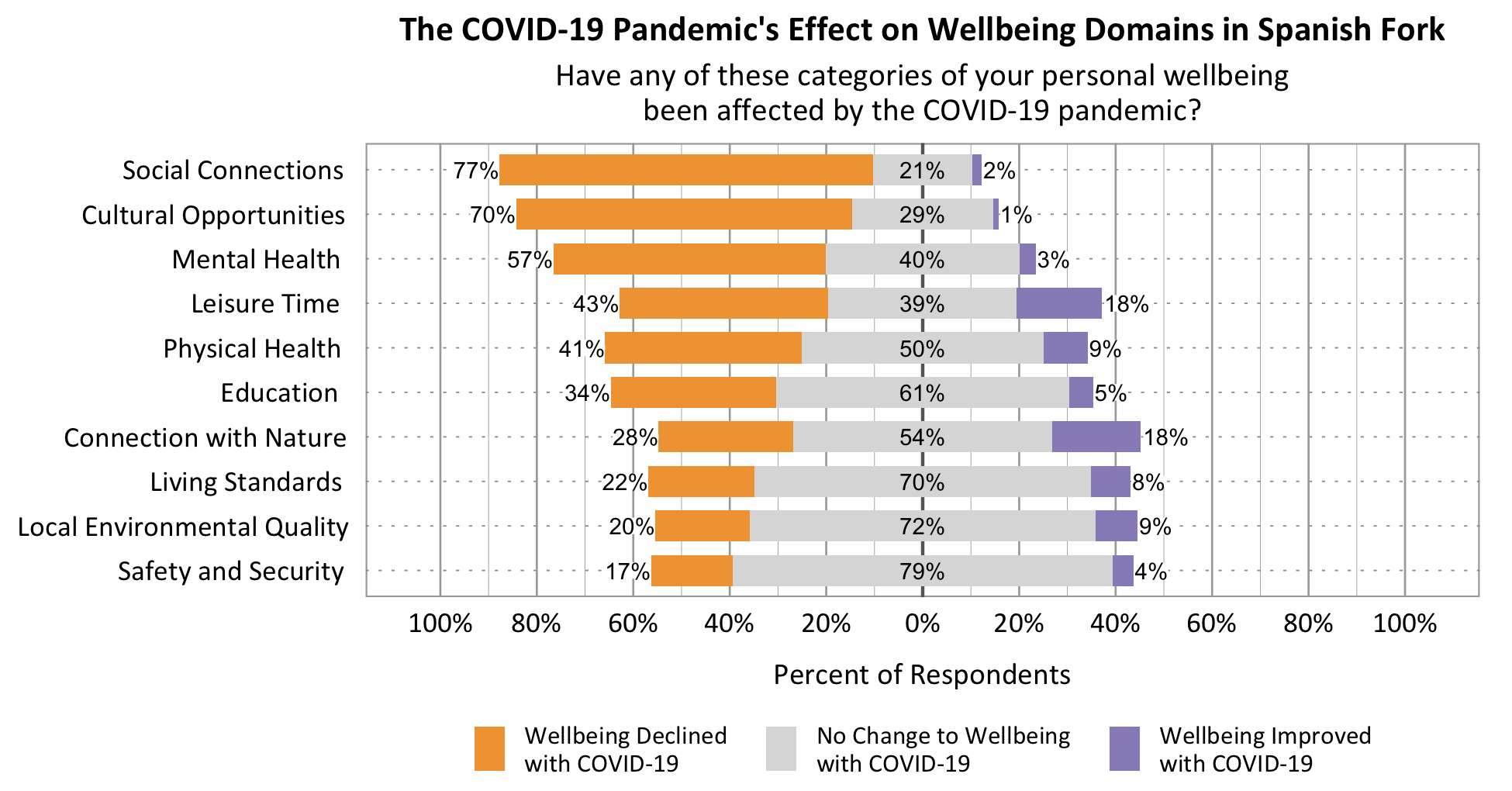
The following relationships were found in Spanish Fork between demographic variables and declines due to COVID-19 pandemic:
Community wellbeing was more likely to decline for those living in Spanish Fork longer than 5 years.
-
Living standards were more likely to decline for those without a college degree
-
Local environmental quality was more likely to decline for those without a college degree.
-
Mental health was more likely to decline for those without a college degree.
-
Physical health was less likely to decline for those age 60+ than those age 40-59.
How are Demographic Characteristics Related to Wellbeing?
The demographic variables age, gender, college degree, religion, income, and length of residence were found to have varying relationships with wellbeing perspectives among Spanish Fork respondents as shown in the table below based on a multivariate generalized linear model based on unweighted data (significance based on p < 0.1). The +/- sign indicates whether the demographic group was statistically significantly higher or lower than others in that category. Colors indicate strongest relationships (p < .05).
Relationship Between Demographic Characteristics and Wellbeing Domains in Spanish Fork
| Domains Rated | Demographic Variables | |||||
|---|---|---|---|---|---|---|
| Age 60+ | Female | College Degree | Latter-day Saint | Higher Income | Resident 5 Years or Less | |
| Wellbeing Ratings | ||||||
| Overall Personal Wellbeing | + | |||||
| Wellbeing in Spanish Fork |
– |
+ Over $150,000 > Under $50,000 |
||||
| Connection to Nature | + vs Age 40-59 |
– vs Other | + Over $150,000> Under $50,000 |
– | ||
| Cultural Opportunities | + vs Age 18-39 |
– | + vs A/A/NRP | |||
| Education | – | + | + vs A/A/NRP | |||
| Leisure Time | + |
– | – vs Other | |||
| Living Standards | – | + | + vs A/A/NRP | + | ||
| Local Environmental Quality | + vs A/A/NRP | + | ||||
| Mental Health | + | – | + Over $150,000 > Under $50,000 |
|||
| Physical Health | + vs A/A/NRP | + Over $150,000 > Under $50,000 |
||||
| Safety & Security | – | – | + | + |
||
| Social Connections | + |
– | ||||
| Age 60+ | Female | College Degree | Latter-day Saint | Higher Income | Resident 5 Years or Less | |
| Domains | Domain Importance | |||||
| Connection to Nature | + vs Age 40-59 |
– vs Other | + | |||
| Cultural Opportunities | + | + | – vs Other | |||
| Education | – |
+ | ||||
| Leisure Time | – | – vs Other | + |
|||
| Living Standards | – vs Other | + | – | |||
| Local Environmental Quality | + |
– | – vs A/A/NP | |||
| Mental Health | – vs Age 18-39 |
+ | ||||
| Physical Health | + vs Age 40-59 |
+ | – vs Other | |||
| Safety and Security | + vs Age 40-59 |
+ |
– vs Other | |||
| Social Connections | + |
+ | + | + vs A/A/NRP | ||
Community Action & Connections in Spanish Fork
Survey participants were asked about community actions and community connection in Spanish Fork. Both questions were scored on a 5-point scale from not at all (1) to a great deal (5). When asked about the degree to which people take action together in response to local problems or opportunities in Spanish Fork, the average score was 3.36. When asked about the degree they feel connected to their community, the average score was 3.26.
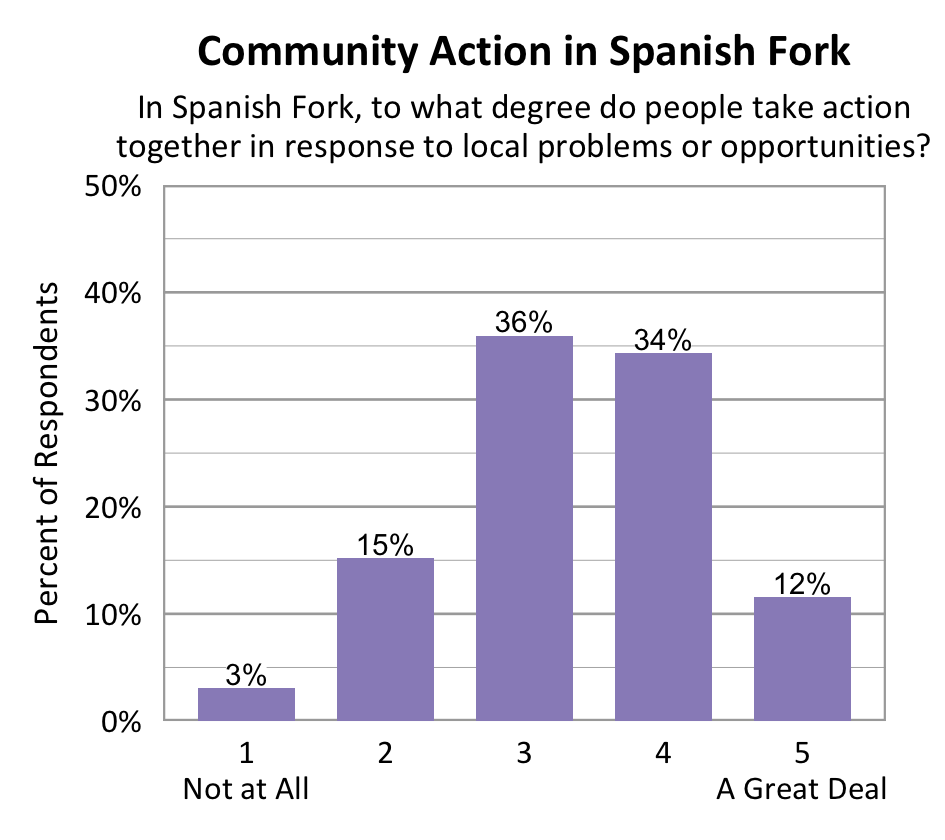
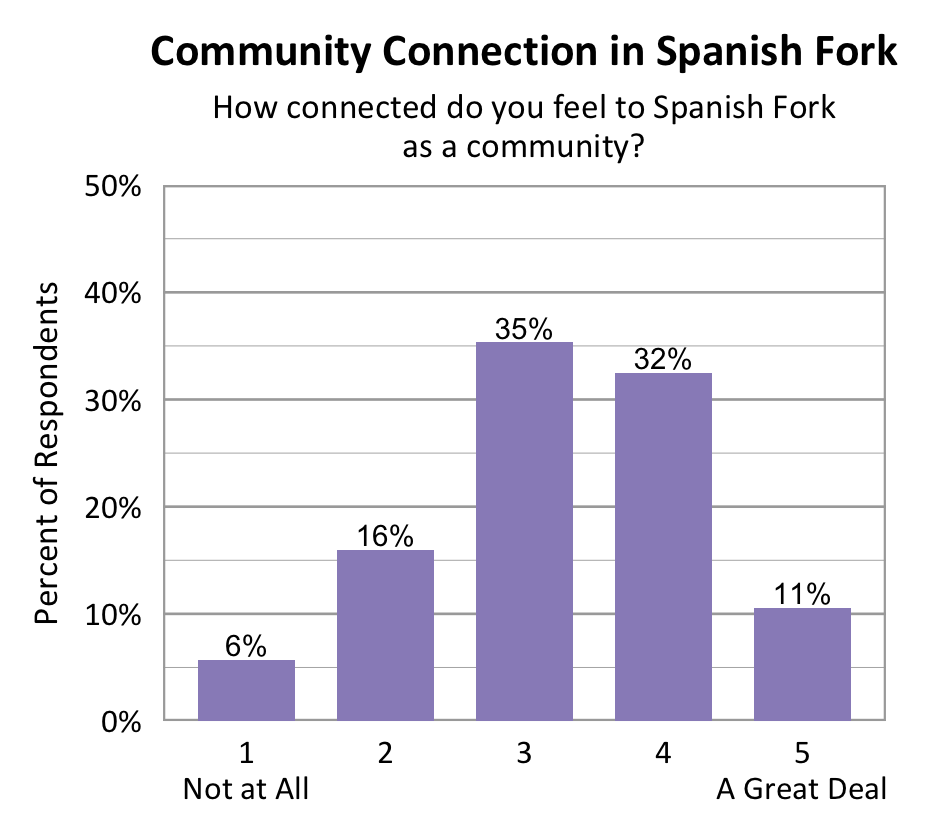
Demographic characteristics were influential regarding community connection and perceptions of local action as shown in the table below based on a multivariate generalized linear model with unweighted data (significance based on p < 0.1). Those age 60+, residents living in Spanish Fork more than 5 years, and Latter-day Saints indicated higher perceptions of local action. Latter-day Saints also indicated greater community connection. Other variables had weaker relationships with community connection. Colors indicate strongest relationships (p < .05).
Demographic Characteristics and Community Questions
| Community Questions | Age 60+ | Female | College Degree | Latter-day Saint | Higher Income | Resident 5 Years or Less |
|---|---|---|---|---|---|---|
| Do people in Spanish Fork take action? | + | + vs A/A/NRP | – | |||
| Do you feel connected to your community? | + vs Age 18-39 |
– | + | – |
A/A/NRP = Agnostic/Atheist/No Religious Preference
A significant, positive relationship was found between individuals’ community connectedness and overall personal wellbeing.
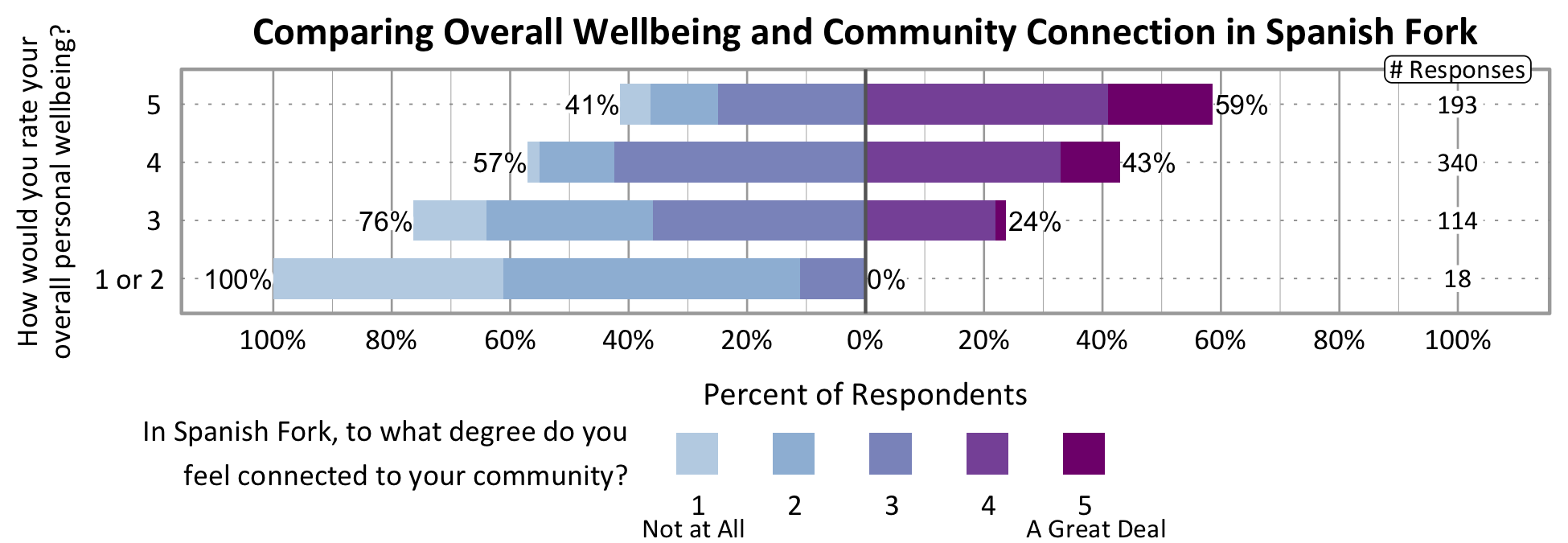
Comparing Community Action and Connection Across Cities
The graphs below show how Wellbeing Project cities compare on the degree to which people take action in response to local problems and opportunities and how connected people feel to their city as a community. Spanish Fork is in the bottom 5 on both perceived community action and in the lower half on community connection based on the number of people indicating a 4 or 5 on a 5-point scale.
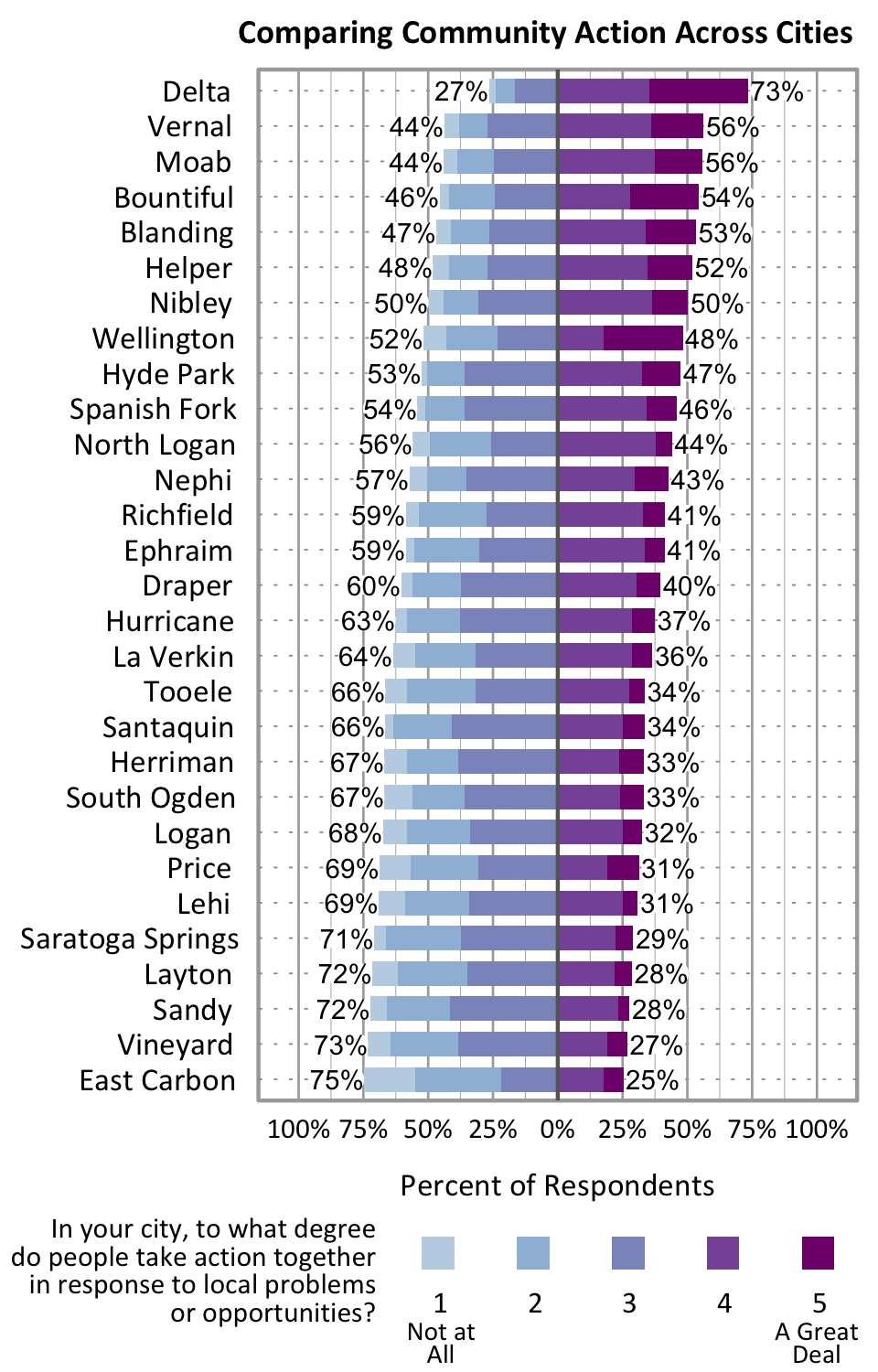
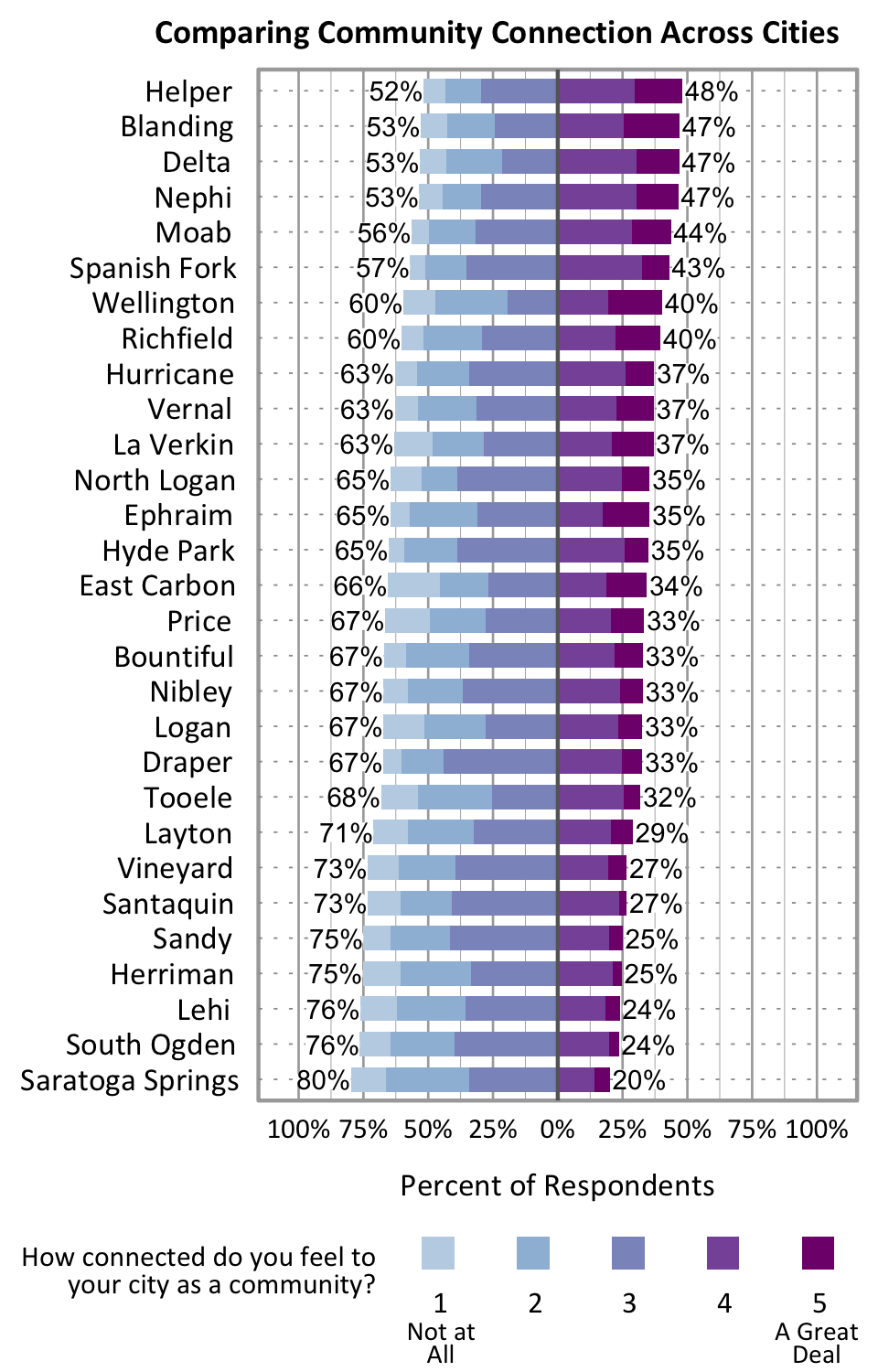
Participation in Community Activities
Respondents were asked to indicate whether or not they participated in seven different activities and a community activeness score was calculated by adding activities. The average community activeness score for Spanish Fork was 2.27. Church group activities were the most common activity for respondents (70%).
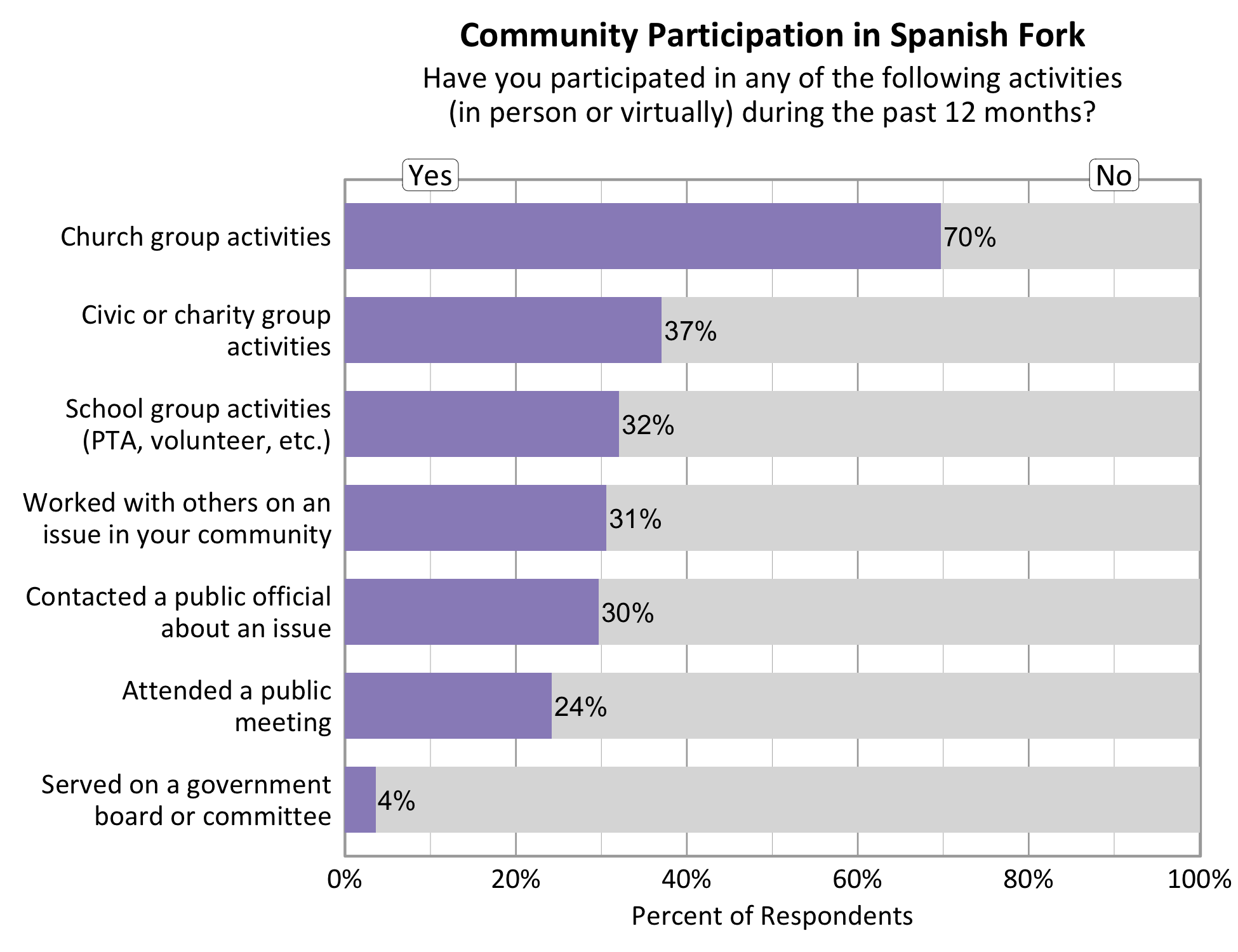
Influence of Landscape on Wellbeing
Survey participants were asked about the influence of landscape features on their wellbeing. Natural landscape including mountains, trails, rivers and streams, and city parks were found to have an overwhelmingly positive influence on wellbeing. In terms of development and industry in the landscape, respondents were more divided.
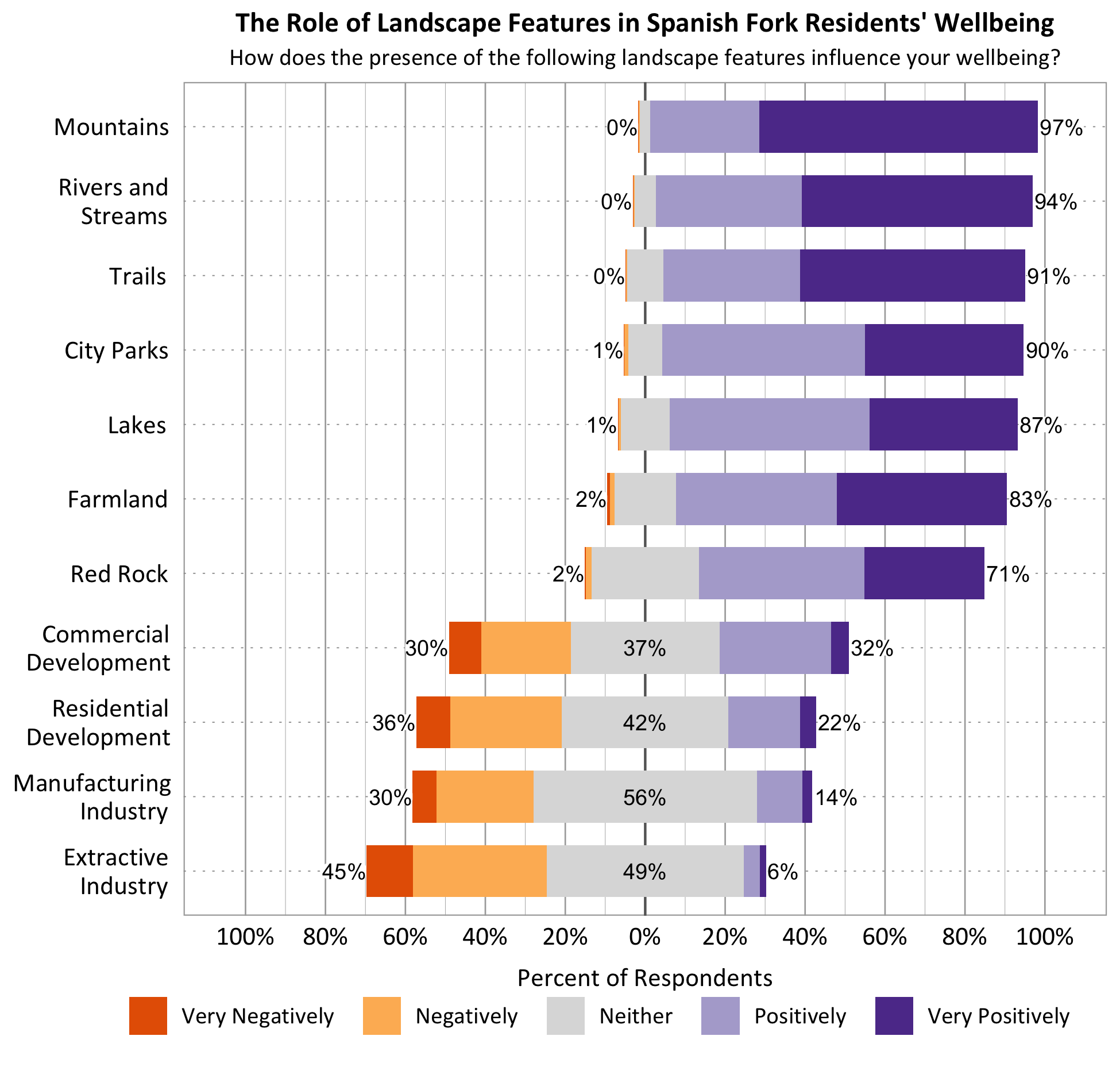
Perspectives on Population Growth and Economic Development
The majority of Spanish Fork survey respondents indicated they felt population growth was too fast (70%), but they were more evenly distributed on the pace of economic development, with 45% indicating just right, and 47% indicating too fast.
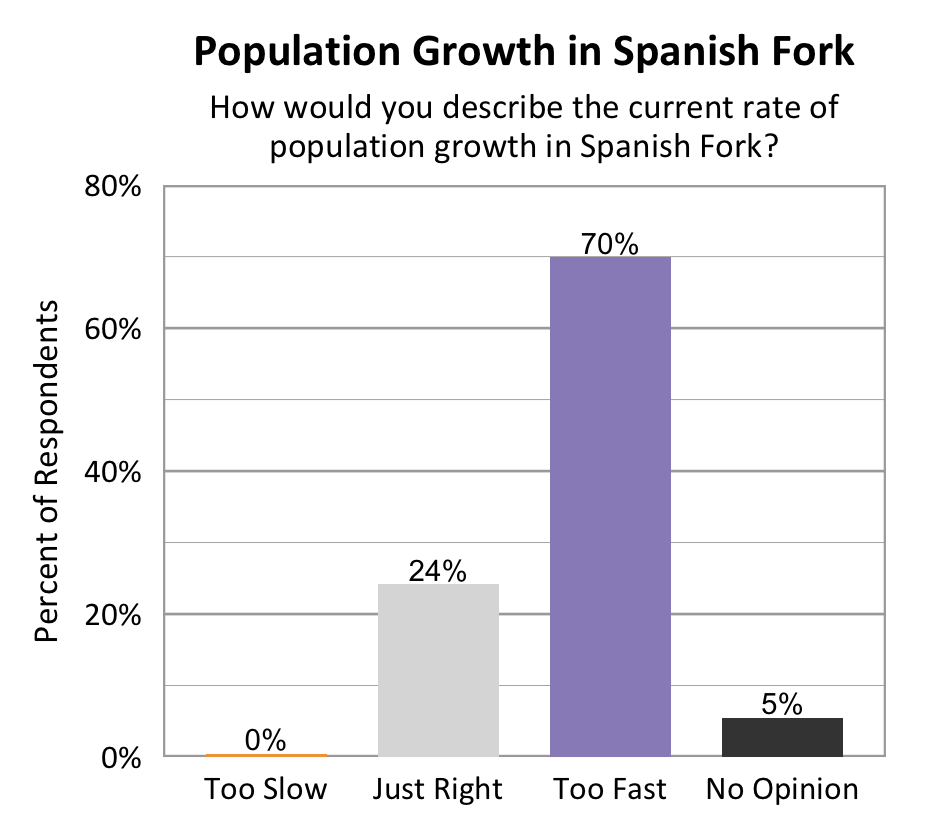
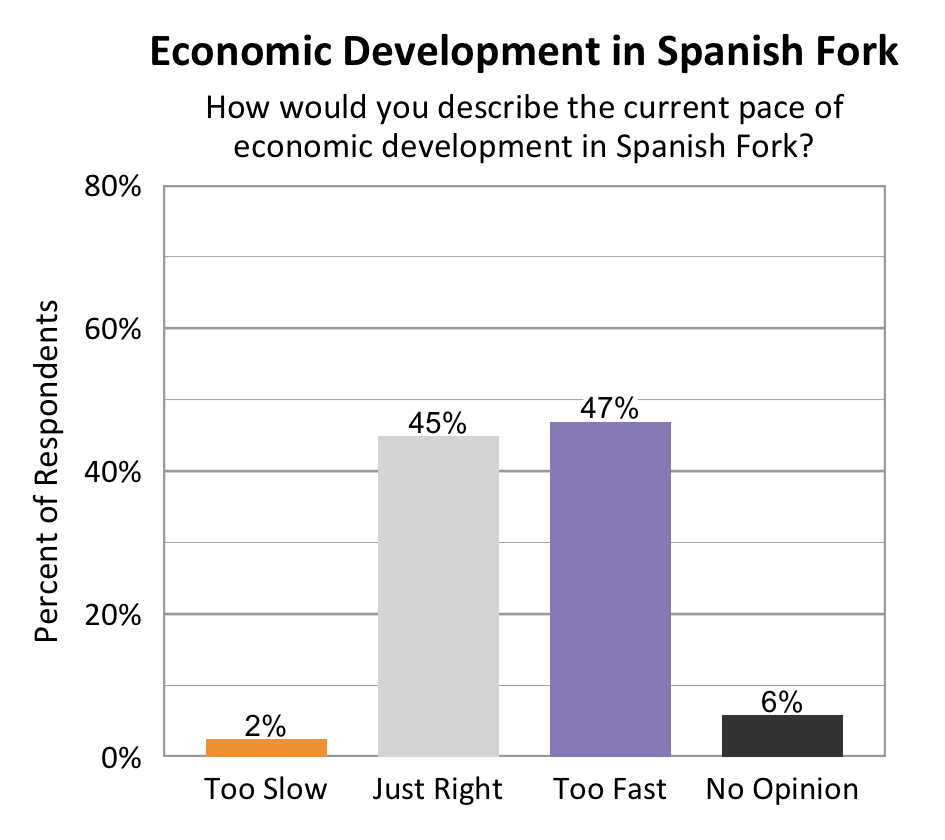
The graphs below show how Spanish Fork compares to other participating cities in the Wellbeing Project on these perceptions of population growth and economic development.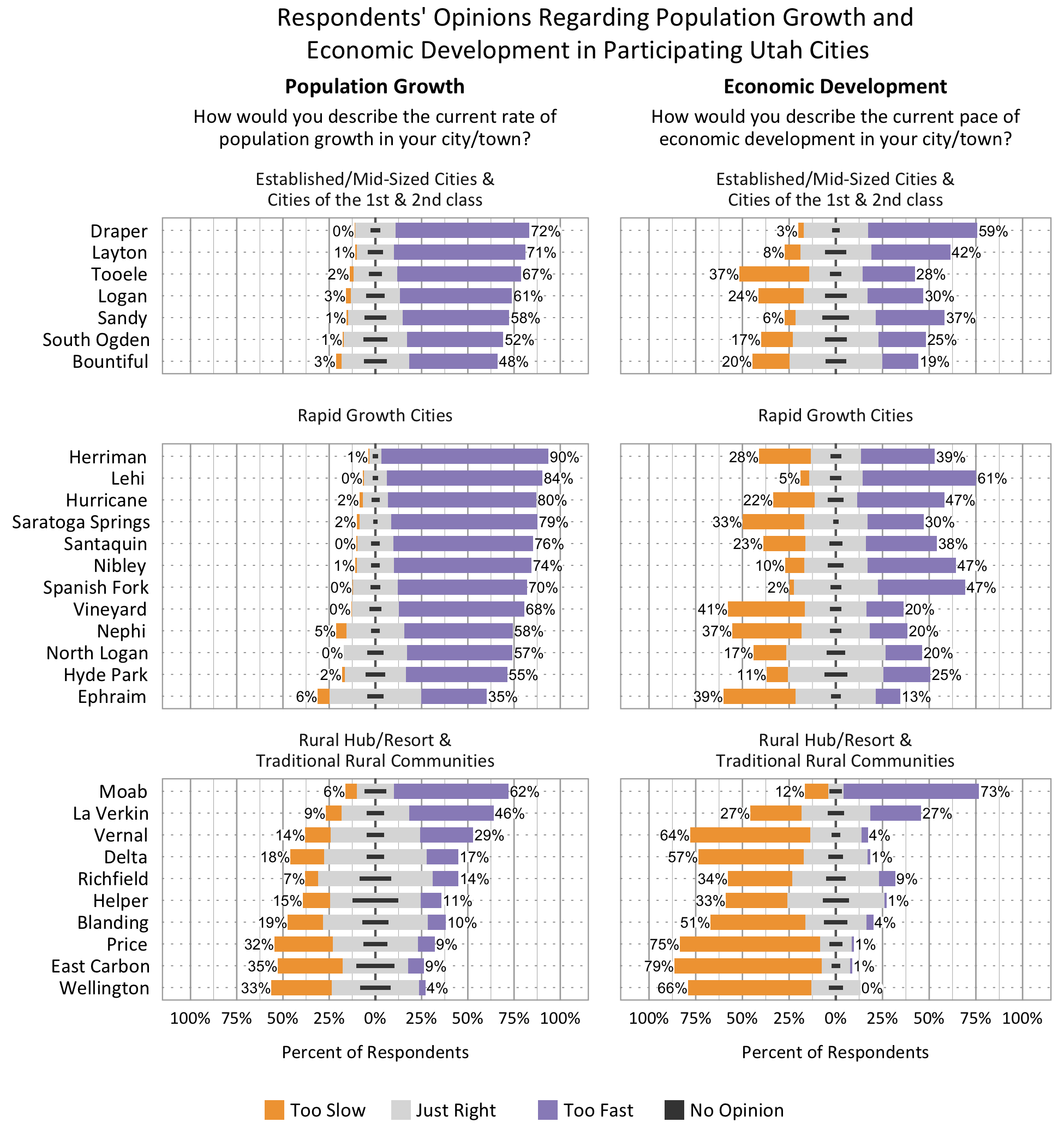
Concerns in Spanish Fork
Survey respondents indicated the degree to which a number of possible local issues were a concern as they look to the future of Spanish Fork. Roads and Transportation, Affordable Housing, and Air Quality were the top three concerns with over two-thirds of respondents indicating these were moderate or major concerns.
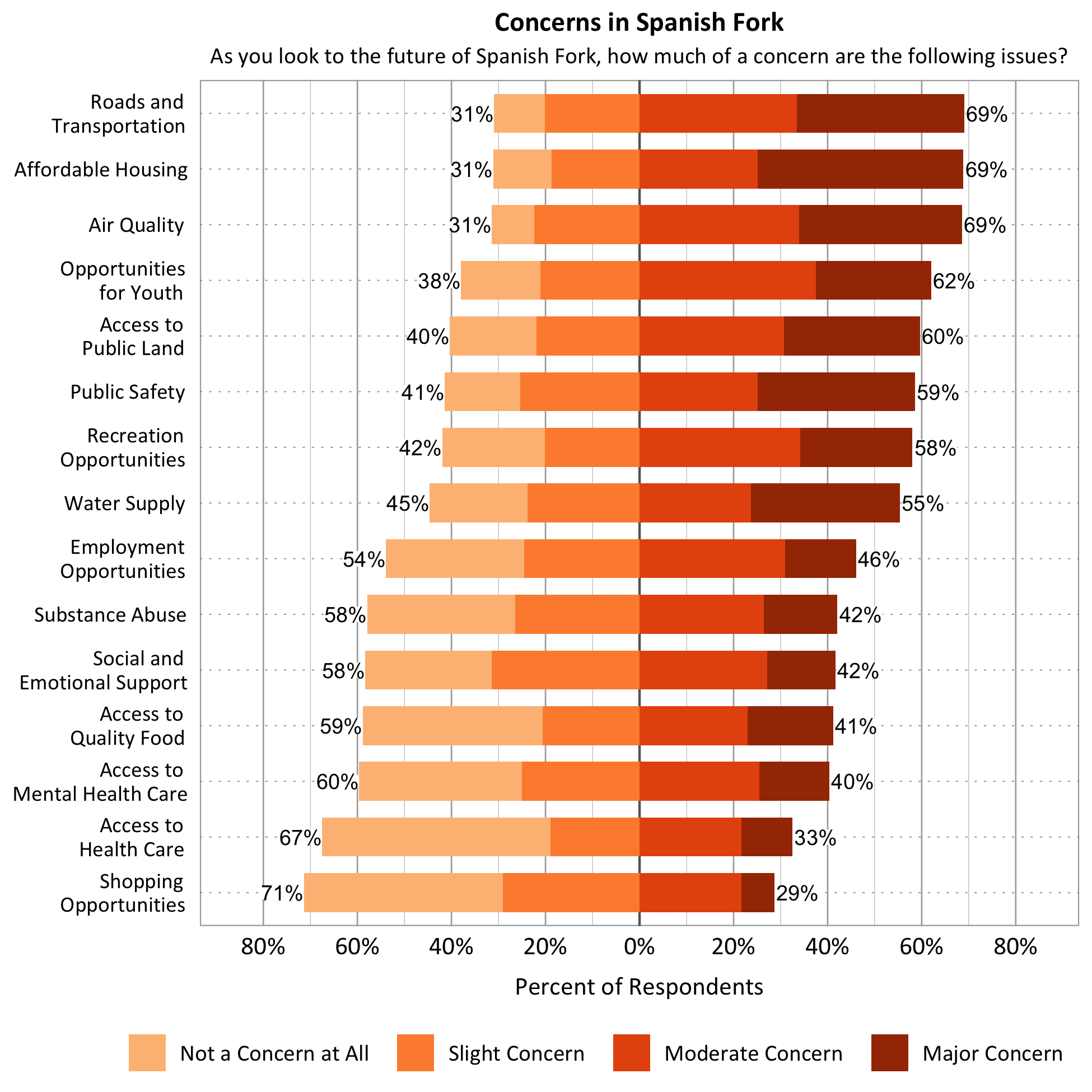
Other concerns were raised by 104 respondents who filled in the “other” category. Traffic and Too much growth were the most common additional concerns.
Other Concerns Mentioned |
Number of Mentions |
Other Concerns Mentioned |
Number of Mentions |
|---|---|---|---|
|
Traffic |
12 | Too much growth | 12 |
|
City government decisions/communication |
7 |
Need for more social and recreation outlets (sports, art, disc golf) |
7 |
|
Better design of roads and infrastructure |
6 | High density housing | 6 |
|
Public transportation services |
6 |
Education quality |
4 |
|
Civil unrest/sense of community |
4 | Increased taxes | 4 |
|
COVID-19 help and safety |
3 |
Overdevelopment of farmland |
3 |
|
Lack of sidewalks/lighting |
3 |
Lack of full-time fire department/EMT |
3 |
|
Maintenance of river bottoms as green space |
2 |
Options for grocery stores and restaurants |
2 |
|
Expand on trails/parks |
2 | Fireflies | 2 |
|
Animal control |
1 |
Cost of living |
1 |
|
Diversity |
1 |
Golf course sprinklers |
1 |
|
High speed internet |
1 |
Improving public library |
1 |
|
Quality of neighborhoods |
1 |
Preserving heritage |
1 |
|
Recreation center |
1 |
Religion prejudices |
1 |
|
Replace sewer lines |
1 | Street parking | 1 |
|
Theft in neighborhoods |
1 | Town loss | 1 |
|
Waste treatment facility |
1 |
Whataburger franchise |
1 |
Summary of Open Comments
The survey provided opportunities for respondents to share their ideas about Spanish Fork with one question on what they value most about their city and another for any additional comments on wellbeing. A summary of values is below. Analysis is ongoing regarding all additional comments and a summary will be added to the report later in 2021.
Key Themes for “Please tell us what you value most about living in Spanish Fork”
- Best of both worlds between small town and big city
- Plenty of trails, parks, nature, and recreation
- Abundant shopping, dining, and entertainment options
- Great city leadership and services
- Beautiful nature views and open farmland

Contact Information
Dr. Courtney Flint
courtney.flint@usu.edu
435-797-8635
On This Page
The Utah League of Cities and Towns is a collaborator on this project and the following people have contributed to this effort in many ways: Casey Trout, Rachel Sagers, Madison Fjeldsted, Jordan Hammon, and Sarah Wilson.
Utah State University is an affirmative action/equal opportunity institution and is committed to a learning and working environment free from discrimination, including harassment. For USU’s non-discrimination notice, see equity.usu.edu/non-discrimination.

